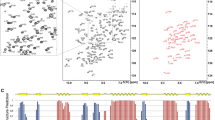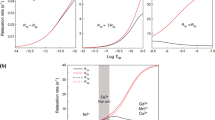Abstract
Here, we report the high yield expression and preliminary structural analysis via solution hetero-nuclear NMR spectroscopy of the recombinant Met-1 human Angiogenin. The analysis reveals a well folded as well as, a monomeric polypeptide. Τhe sequence-specific assignment of its 1H, 15N and 13C resonances at high percentage was obtained. Also, using TALOS+ its secondary structure elements were determined.

Similar content being viewed by others
Abbreviations
- NMR:
-
Nuclear magnetic resonance
- HSQC:
-
Heteronuclear single quantum coherence
- Ang:
-
Angiogenin
References
Banach M, Kalinowska B, Konieczny L, Roterman I (2016) Role of disulfide bonds in stabilizing the conformation of selected enzymes: an approach. Entropy 18(3):67
Bartels C, Xia T, Billeter M, Güntert P, Wüthrich K (1995) The program XEASY for computer supported NMR spectral analysis of biological macromolecules. J Biomol NMR 6:1–10
Chatzileontiadou DSM, Tsirkone VG, Dossi K, Kassouni AG, Liggri PGV, Kantsadi AL, Stravodimos GA, Balatsos NAA, Skamnaki VT, Leonidas DD (2016) The ammonium sulfate inhibition of human angiogenin. FEBS Lett. doi:10.1002/1873-3468.12335
Curran TP, Shapiro R, Riordan JF, Vallee BL (1993) Modulation of the activity of angiogenin by mutagenesis at Asp-116. Biochim Biophys Acta 1202:281–286
Gao X, Xu Z (2008) Mechanisms of action of angiogenin. Acta Biochim Biophys Sin 40:619–624
Gho YS, Chae CB (1997) Anti-angiogenin activity of the peptides complementary to the receptor-binding site of angiogenin. J Biol Chem 272:24294–24299
Gho YS, Yoon WH, Chae CB (2002) Antiplasmin activity of a peptide that binds to the receptor-binding site of angiogenin. J Biol Chem 277:9690–9694
Hallahan TW, Shapiro R, Vallee BL (1991) Dual site model for the organogenic activity of angiogenin. Proc Natl Acad Sci USA 88:2222–2226
Hallahan TW, Shapiro R, Strydom DJ, Vallee BL (1992) Importance of Asparagine-61 and Asparagine-109 to the angiogenic activity of human angiogenin. Biochemistry 31:12477–12485
Harper W, Vallee BL (1988) Mutagenesis of aspartic acid -116 enhances the ribonucleolytic activity and angiogenic potency of angiogenin. Proc Natl Acad Sci USA 85:7139–7142
Harper JW, Fox EA, Shapiro R, Vallee BL (1990) Mutagenesis of residues flanking Lys-40 enhances the enzymatic activity and reduces the Angiogenic potency of angiogenin. Biochemistry 29:7297–7302
Holloway DE, Hares MC, Shapiro R, Subramanian V, Acharya KR (2001) High-level expression of three members of the murine angiogenin family in Escherichia coli and purification of the recombinant proteins. Protein Expr Purif 22:307–317
Hu G-F, Strydom DJ, Fett JW, Riordan JF, Vallee BL (1993) Actin is a binding protein for angiogenin. Proc Natl Acad Sci USA 90:1217–1221
Hu G-F, Riordan JF, Vallee BL (1997) A putative angiogenin receptor in angiogenin-responsive human endothelial cells. Proc Natl Acad Sci USA 94:2204–2209
Jenkins JL, Shapiro R (2003) Identification of small-molecule inhibitors of human angiogenin and characterization of their binding interactions guided by computational docking. Biochemistry 43:6674–6687
Jenkins JL, Kao RY, Shapiro R (2003) Virtual screening to enrich hit lists from high-throughput screening: a case study on small-molecule inhibitors of angiogenin. Proteins 50:81–93
Jimi S, Ito K, Kohno K, Ono M, Kuwano M, Itagaki Y, Ishikawa H (1995) Modulation by bovine angiogenin of tubular morphogenesis and expression of plasminogen activator in bovine endothelial cells. Biochem Biophys Res Commun 211:476–483
Kao RY, Jenkins JL, Olson KA, Key ME, Fett JW, Shapiro R (2002) A small-molecule inhibitor of the ribonucleolytic activity of human angiogenin that possesses antitumor activity. Proc Natl Acad Sci USA 99:10066–10071
Keller R (2004) The computer aided resonance assignment tutorial CH-6410. Cantina Verlag, Goldau
Kim W, Back SH, Kang DI, Shin HC, Kim Y (2008) NMR Assignment of des [40-93] mutant of Bovine Angiogenin. Bull Korean Chem Soc 29:2259–2263
Leonidas DD, Shapiro R, Allen SC, Subbarao GV, Veluraja K, Acharya RK (1999) Refined crystal structures of native human angiogenin and two active site variants: implications for the unique functional properties of an enzyme involved in neovascularisation during tumour growth. J Mol Biol 285(3):1209–1233
Lequin O, Albaret C, Bontems F, Spik G, Lallemand JY (1996) Solution structure of Bovine angiogenin by 1H nuclear magnetic resonance spectroscopy. Biochemistry 35:8870–8880
Lequin O, Thuring H, Robin M, Lallemand J-Y (1997) Three-dimensional solution structure of human angiogenin determined by 1H, 15N-NMR spectroscopy. Characterisation of histidine protonation states and pK a values. Eur J Biochem 250:712–726
Li S, Hu GF (2010) Angiogenin-mediated rRNA transcription in cancer and neurodegeneration. Int J Biochem Mol Biol 1:26–35
Olson KA, Fett JW (1996) Prostatic carcinoma therapy with angiogenin antagonists. Proc Am Assoc Cancer Res 37:57
Olson KA, French TC, Vallee BL, Fett JW (1994) A monoclonal antibody to human angiogenin suppresses tumor growth in athymic mice. Cancer Res 54:4576–4579
Olson KA, Fett JW, French TC, Key ME, Vallee BL (1995) Angiogenin antagonists prevent tumor growth in vivo. Proc Natl Acad Sci USA 92:442–446
Olson KA, Byers HR, Key ME, Fett JW (2001) Prevention of human prostate tumor metastasis in athymic mice by antisense targeting of human angiogenin. Clin Cancer Res 7:3598–3605
Olson KA, Byers HR, Key ME, Fett JW (2002) Inhibition of prostate carcinoma establishment and metastatic growth in mice by an antiangiogenin monoclonal antibody. Int J Cancer 98:923–929
Piccoli R, Olson KA, Vallee BL, Fett JW (1998) Chimeric anti-angiogenin antibody cAb 25-2F inhibits the formation of human breast cancer xenografts in athymic mice. Proc Natl Acad Sci USA 95:4579–4583
Riordan JF (2001) Angiogenin. Methods Enzymol 341:263–273
Schubert M, Labudde D, Oschkinat H, Schmieder P (2002) A software tool for the prediction of Xaa-Pro peptide bond conformations in proteins based on 13C chemical shift statistics. J Biomol NMR 24:149–154
Shapiro R, Vallee BL (1989) Site-directed mutagenesis of Histidine-13 and Histidine-114 of human Angiogenin: Alanine derivatives inhibit Angiogenin-induced angiogenesis. Biochemistry 28:7401–7408
Shapiro R, Vallee BL (1992) Identification of functional arginines in human Angiogenin by site-directed mutagenesis. Biochemistry 31:12477–12485
Shapiro R, Fett JW, Strydom DJ, Vallee BL (1986) Isolation and characterization of a human colon carcinoma secreted enzyme with pancreatic ribonuclease-like activity. Biochemistry 25:7255–7264
Shapiro R, Strydom DJ, Olson KA, Vallee BL (1987) Isolation of Angiogenin from normal human plasma. Biochemistry 26:5141–5146
Shapiro R, Fox EA, Riordan JF (1989) Role of lysines in human angiogenin: chemical modification and site-directed mutagenesis. Biochemistry 28:1726–1732
Sharma DAU, Rajarathnam KTI (2000) 13C NMR chemical shifts can predict disulfide bond formation. J Biomol NMR 18:165–171
Shen Y, Delaglio F, Cornilescu G, Bax A (2009) TALOS: a hybrid method for predicting protein backbone torsion angles from NMR chemical shifts. J Biomol NMR 44:213–223
Strydom DJ, Fett JW, Lobb RR, Alderman EM, Bethune JL, Riordan JF, Vallee BL (1985) Amino-acid sequence of human-tumor derived Angiogenin. Biochemistry 24:5486–5494
Tonan K, Xu P, Jenkins JL, Russo A, Shapiro R, Ni F (2003) Unexpected binding mode for 2′-phosphoadenosine-based nucleotide inhibitors in complex with human angiogenin revealed by heteronuclear NMR spectroscopy. Biochemistry 42:11137–11149. doi:10.1021/bi030066h
Yoshioka N, Wang L, Kishimoto K, Tsuji T, Hu GF (2006) A therapeutic target for prostate cancer based on angiogenin-stimulated angiogenesis and cancer cell proliferation. Proc Natl Acad Sci USA 103:14519–14524
Acknowledgments
“SEE-DRUG” Grant (EU FP7 REGPOT CT-2011-285950; www.seedrug.upatras.gr), is acknowledged for financial support of this work. DSMC & DDL would like to acknowledge the financial support by the Postgraduate Programmes ‘‘Biotechnology-Quality assessment in Nutrition and the Environment”, ‘‘Application of Molecular Biology-Molecular Genetics-Molecular Markers”, Department of Biochemistry and Biotechnology, University of Thessaly.
Author information
Authors and Affiliations
Corresponding authors
Additional information
Aikaterini C. Tsika and Dimitra S. M. Chatzileontiadou have contributed equally to this work.
Rights and permissions
About this article
Cite this article
Tsika, A.C., Chatzileontiadou, D.S.M., Leonidas, D.D. et al. NMR study of Met-1 human Angiogenin: 1H, 13C, 15N backbone and side-chain resonance assignment. Biomol NMR Assign 10, 379–383 (2016). https://doi.org/10.1007/s12104-016-9704-9
Received:
Accepted:
Published:
Issue Date:
DOI: https://doi.org/10.1007/s12104-016-9704-9




